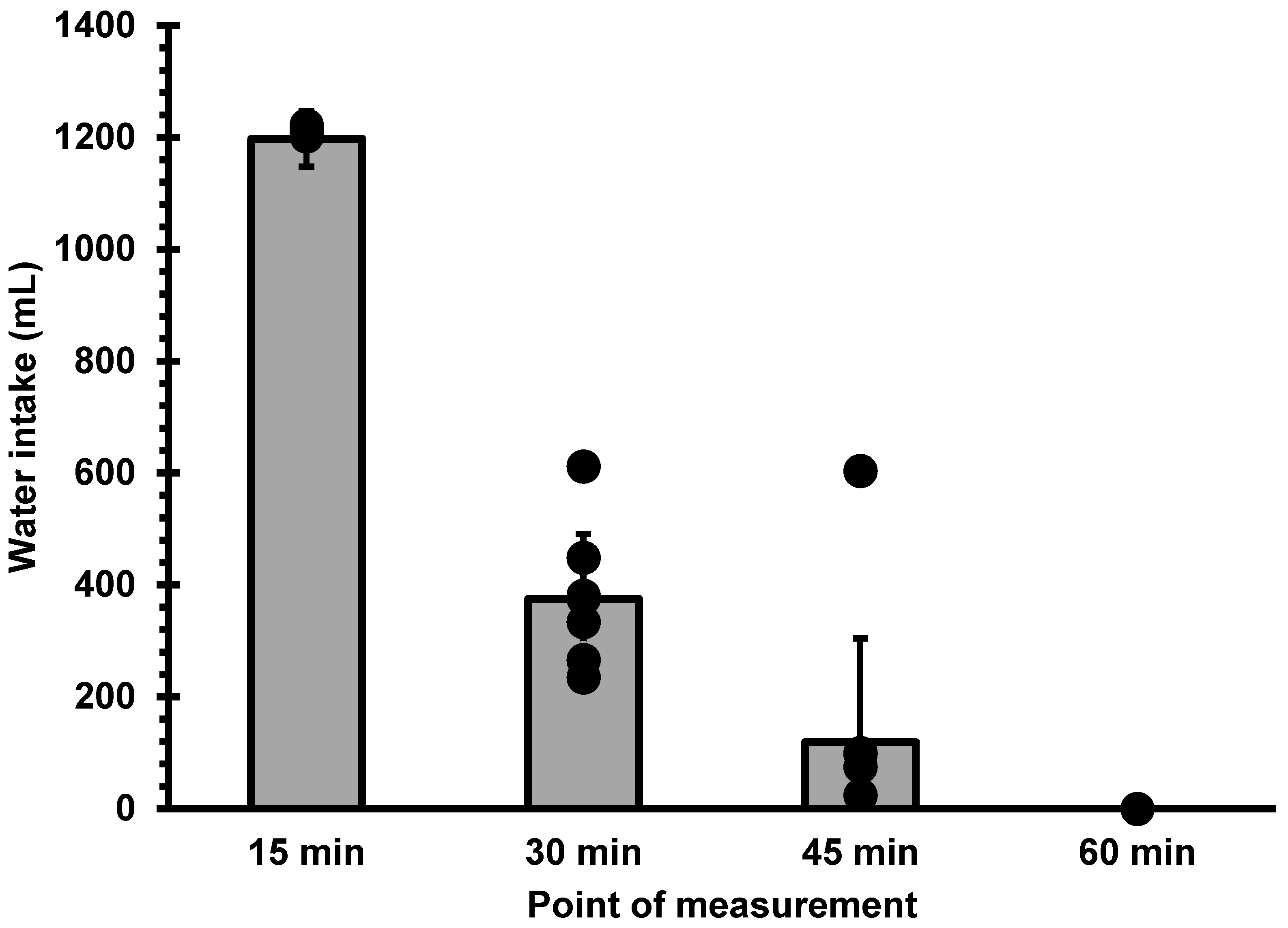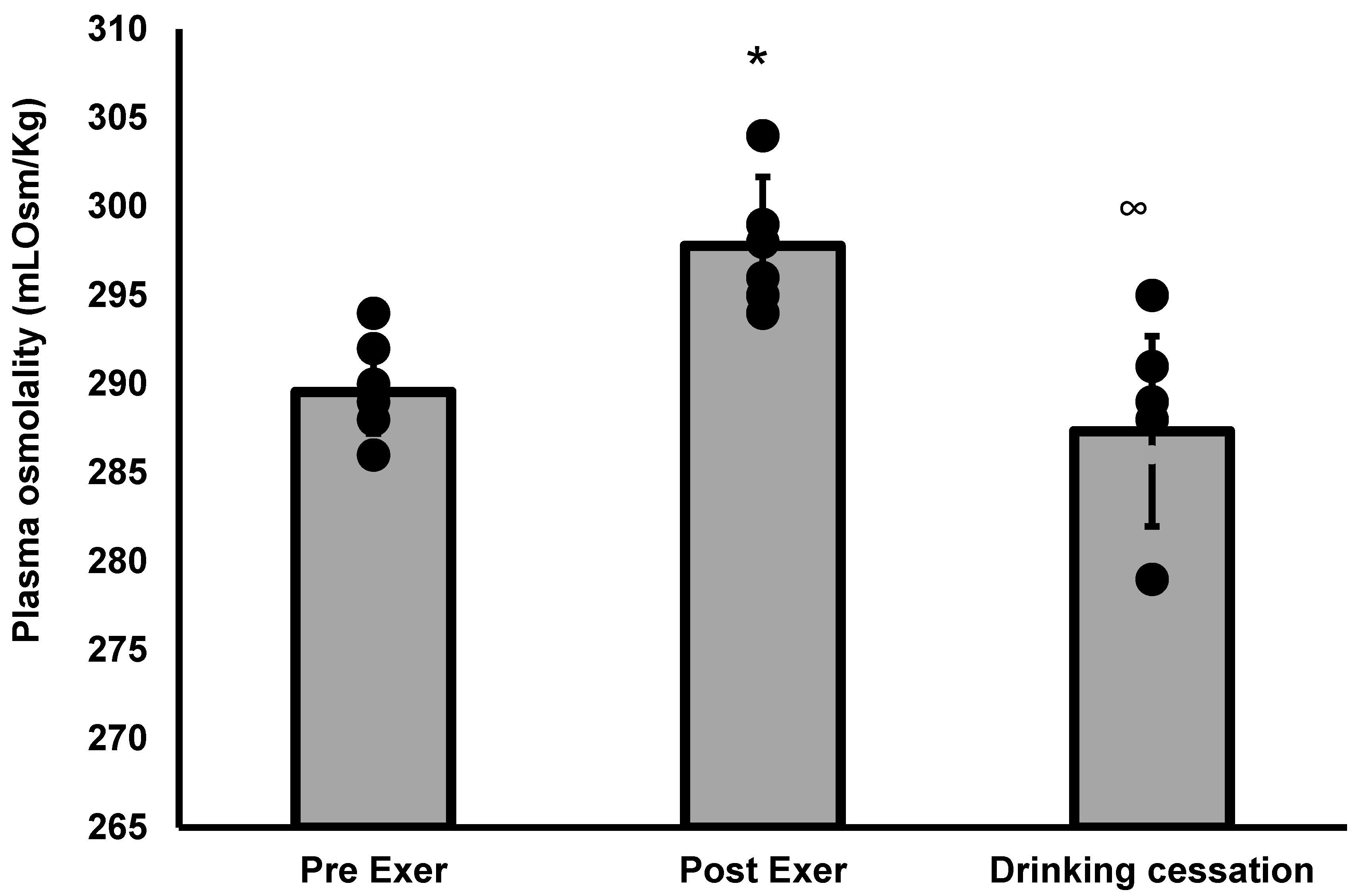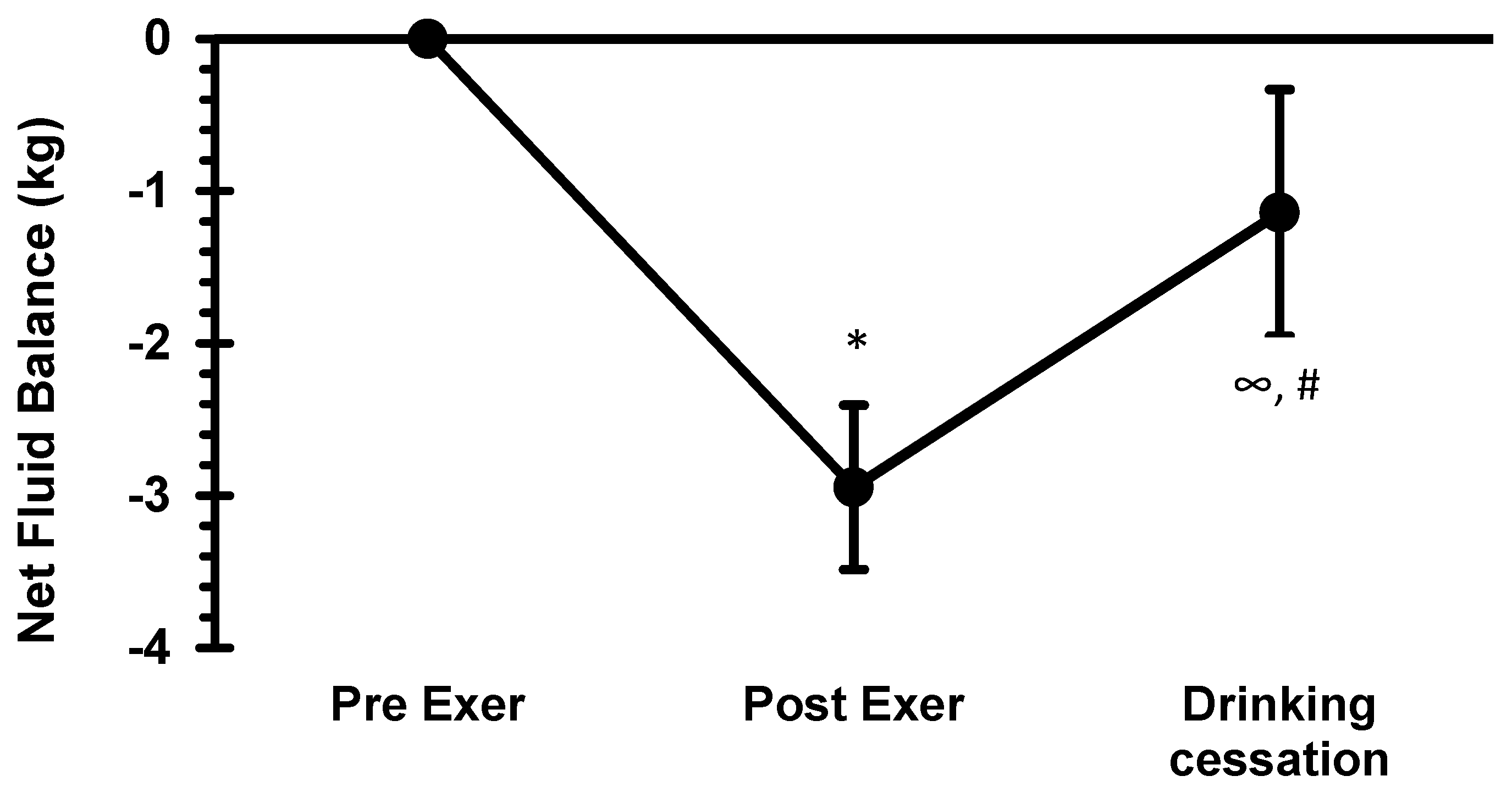Post-Exercise Voluntary Drinking Cessation Is Associated with the Normalization of Plasma Osmolality and Thirst Perception, but Not of Urine Indicators or Net Fluid Balance
Abstract
1. Introduction
2. Materials and Methods
3. Results
4. Discussion
5. Conclusions
Author Contributions
Funding
Institutional Review Board Statement
Informed Consent Statement
Data Availability Statement
Conflicts of Interest
References
- Muñoz, C.X.; Johnson, E.C.; Demartini, J.K.; Huggins, R.A.; McKenzie, A.L.; Casa, D.J.; Maresh, C.M.; Armstrong, L.E. Assessment of Hydration Biomarkers Including Salivary Osmolality during Passive and Active Dehydration. Eur. J. Clin. Nutr. 2013, 67, 1257–1263. [Google Scholar] [CrossRef]
- Pereira, E.R.; de Andrade, M.T.; Mendes, T.T.; Ramos, G.P.; Maia-Lima, A.; Melo, E.S.; Carvalho, M.V.; Wilke, C.F.; Prado, L.S.; Silami-Garcia, E. Evaluation of Hydration Status by Urine, Body Mass Variation and Plasma Parameters during an Official Half-Marathon. J. Sports Med. Phys. Fit. 2017, 57, 1499–1503. [Google Scholar] [CrossRef] [PubMed]
- Villiger, M.; Stoop, R.; Vetsch, T.; Hohenauer, E.; Pini, M.; Clarys, P.; Pereira, F.; Clijsen, R. Evaluation and Review of Body Fluids Saliva, Sweat and Tear Compared to Biochemical Hydration Assessment Markers within Blood and Urine. Eur. J. Clin. Nutr. 2018, 72, 69. [Google Scholar] [CrossRef]
- Allen, S.; Miller, K.C.; Albrecht, J.; Garden-Robinson, J.; Blodgett-Salafia, E. Ad Libitum Fluid Intake and Plasma Responses After Pickle Juice, Hypertonic Saline, or Deionized Water Ingestion. J. Athl. Train. 2013, 48, 734–740. [Google Scholar] [CrossRef] [PubMed]
- Armstrong, L.E.; Soto, J.A.; Hacker, F.T.; Casa, D.J.; Kavouras, S.A.; Maresh, C.M. Urinary Indices during Dehydration, Exercise, and Rehydration. Int. J. Sport Nutr. Exerc. Metab. 1998, 8, 345–355. [Google Scholar] [CrossRef] [PubMed]
- Cutrufello, P.T.; Dixon, C.B.; Zavorsky, G.S. Hydration Assessment among Marathoners Using Urine Specific Gravity and Bioelectrical Impedance Analysis. Res. Sports Med. 2016, 24, 219–227. [Google Scholar] [CrossRef]
- Noakes, T.D. Is Drinking to Thirst Optimum? Ann. Nutr. Metab. 2010, 57, 9–17. [Google Scholar] [CrossRef] [PubMed]
- Greenleaf, J.E. Problem: Thirst, Drinking Behavior, and Involuntary Dehydration. Med. Sci. Sports Exerc. 1992, 24, 645–656. [Google Scholar] [CrossRef] [PubMed]
- Kenefick, R.W. Drinking Strategies: Planned Drinking Versus Drinking to Thirst. Sports Med. 2018, 48, 31–37. [Google Scholar] [CrossRef] [PubMed]
- Maresh, C.M.; Gabaree-Boulant, C.L.; Armstrong, L.E.; Judelson, D.A.; Hoffman, J.R.; Castellani, J.W.; Kenefick, R.W.; Bergeron, M.F.; Casa, D.J. Effect of Hydration Status on Thirst, Drinking, and Related Hormonal Responses during Low-Intensity Exercise in the Heat. J. Appl. Physiol. 2004, 97, 39–44. [Google Scholar] [CrossRef] [PubMed]
- Vandermark, L. Relationship of Perceived Thirst to Measures of Hydration during and Following Exercise. Ph.D. Thesis, University of Connecticut, Mansfield, CT, USA, 2016. [Google Scholar]
- Hew-Butler, T.D.; Eskin, C.; Bickham, J.; Rusnak, M.; Vandermeulen, M. Dehydration Is How You Define It: Comparison of 318 Blood and Urine Athlete Spot Checks. BMJ Open Sport Exerc. Med. 2018, 4, e000297. [Google Scholar] [CrossRef]
- Capitán-Jiménez, C.; Aragón-Vargas, L.F.A. Thirst Response to Post-Exercise Fluid Replacement Needs and Controlled Drinking. Pensar Mov. Rev. Cienc. Ejerc. Salud 2016, 14, 5. [Google Scholar] [CrossRef]
- Capitán-Jiménez, C.; Aragón-Vargas, L.F.A. Percepción de la sed durante el ejercicio y en la rehidratación ad libitum post ejercicio en calor húmedo y seco. Pensar Mov. Rev. Cienc. Ejerc. Salud 2018, 16, e31479. [Google Scholar] [CrossRef]
- Popowski, L.A.; Oppliger, R.A.; Patrick Lambert, G.; Johnson, R.F.; Kim Johnson, A.; Gisolf, C.V. Blood and Urinary Measures of Hydration Status during Progressive Acute Dehydration. Med. Sci. Sports Exerc. 2001, 33, 747–753. [Google Scholar] [CrossRef]
- Armstrong, L.E.; Ganio, M.S.; Klau, J.F.; Johnson, E.C.; Casa, D.J.; Maresh, C.M. Novel Hydration Assessment Techniques Employing Thirst and a Water Intake Challenge in Healthy Men. Appl. Physiol. Nutr. Metab. 2013, 39, 138–144. [Google Scholar] [CrossRef]
- Armstrong, L.; Johnson, E.C.; Bergeron, M.F. COUNTERVIEW: Is Drinking to Thirst Adequate to Appropriately Maintain Hydration Status During Prolonged Endurance Exercise? No. Wilderness Environ. Med. 2016, 27, 195–198. [Google Scholar] [CrossRef] [PubMed]
- Adams, J.D.; Sekiguchi, Y.; Suh, H.G.; Seal, A.D.; Sprong, C.A.; Kirkland, T.W.; Kavouras, S.A. Dehydration Impairs Cycling Performance, Independently of Thirst: A Blinded Study. Med. Sci. Sports Exerc. 2018, 50, 1697–1703. [Google Scholar] [CrossRef]
- Armstrong, L.E.; Johnson, E.C.; Kunces, L.J.; Ganio, M.S.; Judelson, D.A.; Kupchak, B.R.; Vingren, J.L.; Munoz, C.X.; Huggins, R.A.; Hydren, J.R.; et al. Drinking to Thirst Versus Drinking Ad Libitum During Road Cycling. J. Athl. Train. 2014, 49, 624–631. [Google Scholar] [CrossRef] [PubMed]
- Engell, D.B.; Maller, O.; Sawka, M.N.; Francesconi, R.N.; Drolet, L.; Young, A.J. Thirst and Fluid Intake Following Graded Hypohydration Levels in Humans. Physiol. Behav. 1987, 40, 229–236. [Google Scholar] [CrossRef]
- Hughes, F.; Mythen, M.; Montgomery, H. The Sensitivity of the Human Thirst Response to Changes in Plasma Osmolality: A Systematic Review. Perioper. Med. 2018, 7, 1. [Google Scholar] [CrossRef]
- Morton, D.P.; Aragón-Vargas, L.F.; Callister, R. Effect of Ingested Fluid Composition on Exercise-Related Transient Abdominal Pain. Int. J. Sport Nutr. Exerc. Metab. 2004, 14, 197–208. [Google Scholar] [CrossRef] [PubMed]
- Adams, W.M.; Vandermark, L.W.; Belval, L.N.; Casa, D.J. The Utility of Thirst as a Measure of Hydration Status Following Exercise-Induced Dehydration. Nutrients 2019, 11, 2689. [Google Scholar] [CrossRef] [PubMed]
- Adams, J.D.; Darcy, C.; DeGrasse, A.G.; Jordan, R.; Boscia, C.S. Crosstalk of Pain and Thirst Perception: A Brief Review. Chemosens. Percept. 2021, 14, 75–78. [Google Scholar] [CrossRef]
- Young, A.J.; Sawka, M.N.; Epstein, Y.; Decristofano, B.; Pandolf, K.B. Cooling Different Body Surfaces during Upper and Lower Body Exercise. J. Appl. Physiol. 1987, 63, 1218–1223. [Google Scholar] [CrossRef] [PubMed]
- Mears, S.A.; Watson, P.; Shirreffs, S.M. Thirst Responses Following High Intensity Intermittent Exercise When Access to Ad Libitum Water Intake Was Permitted, Not Permitted or Delayed. Physiol. Behav. 2016, 157, 47–54. [Google Scholar] [CrossRef] [PubMed]
- Leib, D.E.; Zimmerman, C.A.; Knight, Z.A. Thirst. Curr. Biol. 2016, 26, R1260–R1265. [Google Scholar] [CrossRef]
- Utter, A.C.; McAnulty, S.R.; Riha, B.F.; Pratt, B.A.; Grose, J.M. The Validity of Multifrequency Bioelectrical Impedance Measures to Detect Changes in the Hydration Status of Wrestlers during Acute Dehydration and Rehydration. J. Strength Cond. Res. 2012, 26, 9–15. [Google Scholar] [CrossRef]
- Noakes, T.D. Drinking Guidelines for Exercise: What Evidence Is There That Athletes Should Drink “as Much as Tolerable”, “to Replace the Weight Lost during Exercise” or “Ad Libitum”? J. Sports Sci. 2007, 25, 781–796. [Google Scholar] [CrossRef]
- Fan, P.W.; Burns, S.F.; Lee, J.K.W. Jason Efficacy of Ingesting an Oral Rehydration Solution after Exercise on Fluid Balance and Endurance Performance. Nutrients 2020, 12, 3826. [Google Scholar] [CrossRef]
- Maughan, R.J.; Watson, P.; Cordery, P.A.A.; Walsh, N.P.; Oliver, S.J.; Dolci, A.; Rodriguez-Sanchez, N.; Galloway, S.D.R. Sucrose and Sodium but Not Caffeine Content Influence the Retention of Beverages in Humans Under Euhydrated Conditions. Int. J. Sport Nutr. Exerc. Metab. 2019, 29, 51–60. [Google Scholar] [CrossRef]
- Peyrot des Gachons, C.; Avrillier, J.; Gleason, M.; Algarra, L.; Zhang, S.; Mura, E.; Nagai, H.; Breslin, P.A.S. Oral Cooling and Carbonation Increase the Perception of Drinking and Thirst Quenching in Thirsty Adults. PLoS ONE 2016, 11, e0162261. [Google Scholar] [CrossRef] [PubMed]
- Best, R.; Crosby, S.; Berger, N.; McDonald, K. The Effect of Isolated and Combined Application of Menthol and Carbohydrate Mouth Rinses on 40 Km Time Trial Performance, Physiological and Perceptual Measures in the Heat. Nutrients 2021, 13, 4309. [Google Scholar] [CrossRef] [PubMed]
- Leiper, J.B. Fate of Ingested Fluids: Factors Affecting Gastric Emptying and Intestinal Absorption of Beverages in Humans. Nutr. Rev. 2015, 73, 57–72. [Google Scholar] [CrossRef] [PubMed]






| Subject | Time | Body Weight (kg) | Intake (mL) | mL/kg | % |
|---|---|---|---|---|---|
| 1 | 15 | 70.91 | 1217 | 17.2 | 72.31 |
| 30 | 71.95 | 441 | 6.1 | 26.20 | |
| 45 | 72.50 | 25 | 0.3 | 1.49 | |
| 2 | 15 | 81.50 | 1211 | 14.9 | 49.90 |
| 30 | 83.12 | 612 | 7.4 | 25.22 | |
| 45 | 83.67 | 604 | 7.2 | 24.89 | |
| 3 | 15 | 84.50 | 1066 | 12.6 | 73.77 |
| 30 | 86.00 | 282 | 3.3 | 19.52 | |
| 45 | 86.20 | 97 | 1.1 | 6.71 | |
| 4 | 15 | 108.62 | 1214 | 11.2 | 69.85 |
| 30 | 110.14 | 449 | 4.1 | 25.83 | |
| 45 | 110.18 | 75 | 0.7 | 4.32 | |
| 5 | 15 | 79.95 | 1222 | 15.3 | 73.88 |
| 30 | 81.39 | 334 | 4.1 | 20.19 | |
| 45 | 81.48 | 98 | 1.2 | 5.93 | |
| 6 | 15 | 65.53 | 1215 | 18.5 | 78.39 |
| 30 | 66.92 | 235 | 3.5 | 15.16 | |
| 45 | 67.60 | 100 | 1.5 | 6.45 | |
| 7 | 15 | 75.40 | 1213 | 16.1 | 80.71 |
| 30 | 77.99 | 266 | 3.4 | 17.70 | |
| 45 | 78.37 | 24 | 0.3 | 1.60 | |
| 8 | 15 | 77.88 | 1216 | 15.6 | 75.02 |
| 30 | 79.25 | 381 | 4.8 | 23.50 | |
| 45 | 79.45 | 24 | 0.3 | 1.48 | |
| 9 | 15 | 70.91 | 1217 | 17.2 | 75.03 |
| 30 | 76.84 | 376 | 4.9 | 23.47 | |
| 45 | 77.14 | 24 | 0.3 | 1.50 |
Publisher’s Note: MDPI stays neutral with regard to jurisdictional claims in published maps and institutional affiliations. |
© 2022 by the authors. Licensee MDPI, Basel, Switzerland. This article is an open access article distributed under the terms and conditions of the Creative Commons Attribution (CC BY) license (https://creativecommons.org/licenses/by/4.0/).
Share and Cite
Capitán-Jiménez, C.; Aragón-Vargas, L.F. Post-Exercise Voluntary Drinking Cessation Is Associated with the Normalization of Plasma Osmolality and Thirst Perception, but Not of Urine Indicators or Net Fluid Balance. Nutrients 2022, 14, 4188. https://doi.org/10.3390/nu14194188
Capitán-Jiménez C, Aragón-Vargas LF. Post-Exercise Voluntary Drinking Cessation Is Associated with the Normalization of Plasma Osmolality and Thirst Perception, but Not of Urine Indicators or Net Fluid Balance. Nutrients. 2022; 14(19):4188. https://doi.org/10.3390/nu14194188
Chicago/Turabian StyleCapitán-Jiménez, Catalina, and Luis Fernando Aragón-Vargas. 2022. "Post-Exercise Voluntary Drinking Cessation Is Associated with the Normalization of Plasma Osmolality and Thirst Perception, but Not of Urine Indicators or Net Fluid Balance" Nutrients 14, no. 19: 4188. https://doi.org/10.3390/nu14194188
APA StyleCapitán-Jiménez, C., & Aragón-Vargas, L. F. (2022). Post-Exercise Voluntary Drinking Cessation Is Associated with the Normalization of Plasma Osmolality and Thirst Perception, but Not of Urine Indicators or Net Fluid Balance. Nutrients, 14(19), 4188. https://doi.org/10.3390/nu14194188







